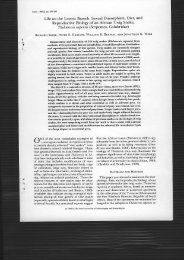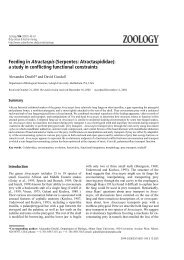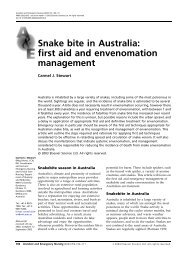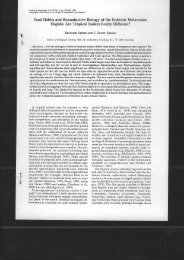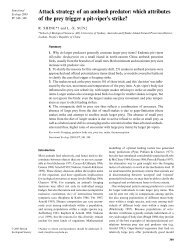Introduction - Kingsnake.com
Introduction - Kingsnake.com
Introduction - Kingsnake.com
You also want an ePaper? Increase the reach of your titles
YUMPU automatically turns print PDFs into web optimized ePapers that Google loves.
Clinical Management of Snakebite in Papua New Guinea Chapter 2<br />
Snakes of Papua New Guinea<br />
David Williams<br />
<strong>Introduction</strong><br />
Papua New Guinea is home to a wide diversity of snake species which have adapted to live in<br />
almost all habitats; from coastal mangroves through to highland forests. Virtually all of them<br />
are openly feared, and many snakes are killed through fear, despite that fact that of more than<br />
112 different varieties, fewer than half a dozen have killed humans, and the majority of<br />
human deaths have been due to just one snake in particular.<br />
The snakes of PNG fall into six taxonomic Families:<br />
NON-VENOMOUS Blind snakes or worm snakes (Family Typhlopidae)<br />
11 species<br />
? Small burrowing snakes with rudimentary eyes (hence the name ‘blind snake’).<br />
? Characteristic small smooth scales with a down turned spine on the tip of the tail that<br />
is used as an anchor (and contains NO poisonous sting).<br />
? Shovel-shaped head for use when burrowing.<br />
? Typically nocturnal, but may <strong>com</strong>e to the surface during rain.<br />
NON-VENOMOUS File snakes (Family Acrochordidae)<br />
2 species<br />
? Aquatic snakes in both brackish water and estuaries.<br />
? Named for their very rough, loose fitting skin; also called ‘wart snakes’ or ‘elephant<br />
trunk snakes’.<br />
? Very agile in the water but have difficulty moving on land.<br />
NON-VENOMOUS Pythons and boas (Family Boidae)<br />
11 species<br />
? The three small (< 1 metre) boa species are viviparous – they produce live young.<br />
? Two harmless species resemble highly venomous death adders in body size, shape<br />
and habits, and are often needlessly killed.<br />
? Pythons range in size from 1 to 6 metres in length and reproduce by laying eggs.<br />
? Nearly all Papuan pythons are nocturnal, and have heat-sensing pits which they use<br />
for tracking prey in total darkness.<br />
? Large pythons are extremely strong and can easily suffocate an adult human being,<br />
although it is very unlikely that they could swallow one. There are anecdotal claims<br />
of children having been eaten by large pythons.<br />
? PNG’s only legally protected snake is Boelen’s python (Morelia boeleni); a large<br />
black and white snake that occurs in cool Highland forests.<br />
- 2.1 -




